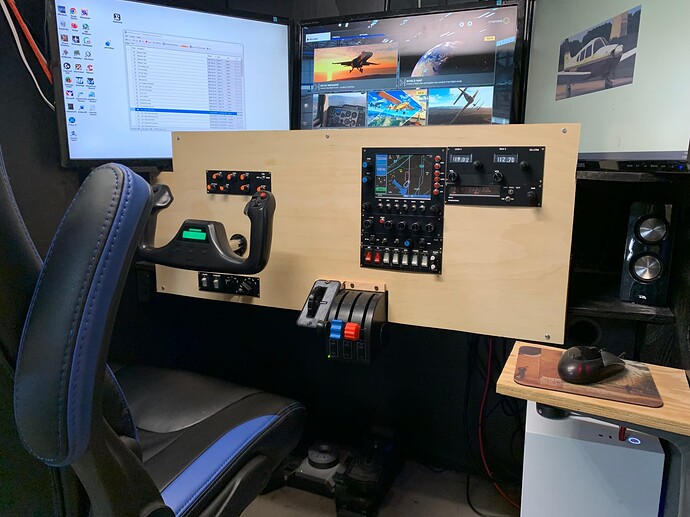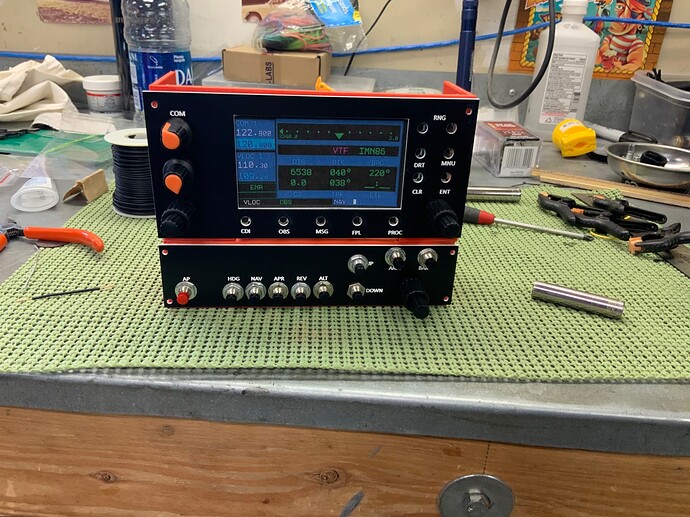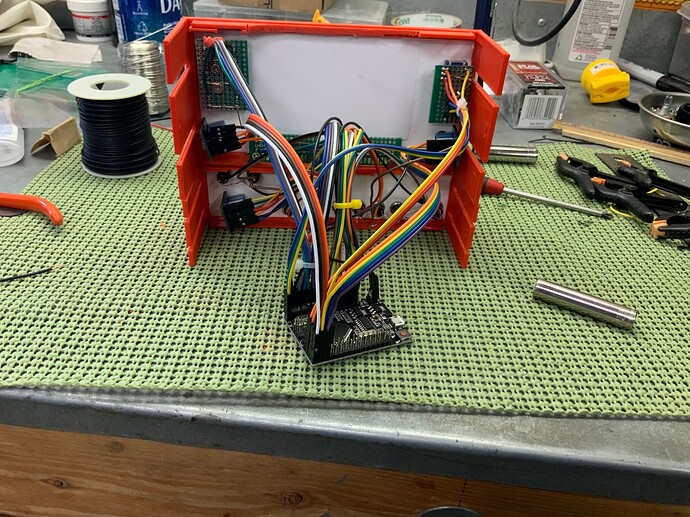It would of been even cheaper if you had not purchased the Saitek panels and used your own switches/buttons/dials interfaced via an Arduino. I like the ingenuity though. Once you’ve used external controls you never want to go back to fumbling around with a mouse in the VC so any external control solution however simple or complex is better than that.
Can Air Manager take input from the Saitek switch Panel and Mode Control Panel without the Saitek driver or Spad.Next?
Yes if it is recognised as a standard Windows game controller.
I’ve been using the class echo since October and it’s awesome. Easy to build. Sstup was quick. Paired up with an Alpha, Bravo, tobii eye tracker, butt kicker, and 50 inch TV it’s 99% hands off the mouse. (Depending on what you fly)
Easier and just as cheap to use Leo Bodnar interface cards. I’ve got some great videos for beginners and intermediate cockpit builders. I call freeing yourself completely from keyboard/mouse: reaching NokeNomo status.
Youtube: joshuamarius
Great idea with the gamepad garmin mapping
Yes control is really easy with it, using the menus and adding airport codes.
I have mapped the right side of the Garmin → inner and outer right side knob I have mapped the dpad, small button next to dpad for the press of the knob itself, XYAB buttons for the right column buttons, start button for PROC, select button for CDI - VLOC/GPS - (Toggle_gps_Drives_Nav1 - is the msfs spad.next command for that btw) and the triggers for zoom in/out, home button to FPL, two small triggers VNAV/MSG/OBS set to long/short press.
The left side of the garmin is done with radio panel.
Looks great, I am thinking of making my own Garmin without screen.
I never recommend those over priced Leo Bodnar boards for this kind of thing. They connect as a game controller and have limitations as a result. Much cheaper and flexible to use Arduino or similar.
Yes indeed. I have three in this sim. One just for the 430 and 140. I’m moving off of the Leo Bondar board for the final build. These are just POC devices.
Where did you get the bottom row of switches (starting with 2 red ones)? I need a replacement for my Saitek switch panel it keeps acting up.
Amazon. Clyewet push button switch
Oh that is custom made. I thought it was a single unit.
The Leo Bodnar cards require no programming. In reality one is a HID Device (Leo Bodnar) and the other one is an Interface Card (Arduino). There is a good video on my channel about all of your options. Some HID cards you can get on Amazon for as low as $12. For those starting up that just want to plug a switch, pushbutton or rotary encoder using the simplest methods, no soldering or programming, HID devices such as Leo Bodnar is the way to go ![]()
![]()
You are now changing what you originally said. The Leo boards are more expensive than Arduino and for what they are are over priced IMHO. An Arduino can also do HID if required. As far as the connecting is concerned neither is any easier or harder than the other. You’ll likely need to solder something with either type. The only benefit you mention is no programming required and even with that it has big downsides. Encoders are not as responsive when rotated fast, you are forced to use the default key bindings which are limited and you still need to spend time figuring out which ones to use. In my view if you are messing with additional boards, switches, buttons and encoders etc then you should expect a level of programming/configuration anyhow so this is hardly any advantage and limits what you can do without having to delve ins bit. Besides the programming/configuration is easy with tools like Air Manager, Mobiflight, SPAD, Axis & Ohs etc.
…and that’s why I cover all of the cards in my video with all the options and prices available. Definitely not true about soldering or programming; look into quick spade connectors and the Leo Bodnars have a quick snap-in. We have in depth discussions about all those topics regarding these cards. In some cases we have setups with both. The Leo Bodnars are expensive, but they will work just as well except they have no interfacing. And the non-responsiveness in the encoders, has never been my case. Many people are willing to pay a bit more so they don’t have to configure anything and that is what the Leo’s offer; plug it in and you are off instantly - no drivers, plug and play and configurable within seconds in any Simulator. And no, your view is not accurate. Not all additional boards, switches, buttons and encoders need any level of programming as I explain in my videos. You can, of course, but it’s not 100% necessary and is an alternative to all the configurations and programming.
I can’t believe you are trying to suggest a quick spade will connect to most electronic components. They may work for some switches but you will almost certainly need to solder for anything other than the most basic stuff. The Bodnar quick snap can be replicated with a shield if wanted.
Only configurable if the sim has a binding for that. A search of just this forum alone will tell you that the default bindings are lacking to say the least and to get control of many of the things that they don’t cover you need to delve into additional programming or configuration. Yes if you just want something simple they can be ok but it’s never normally that straight forward. For others reading this, If you go this way expecting the same level of control as others enjoy just using the in sim bindings then be aware that you will end up disappointed.
It’s very accurate. I didn’t suggest that was the case. What I suggested was it is limited beyond the simple stuff. If you want to control add on LVARs and many of the functions not supported by the in sim bindings then you will need to get involved with configuration/programming.
If people want to use the expensive Bodnar boards that is their choice. I’m just laying out the facts so they don’t go in blind.
LOL. Thanks for the reply. The spade connectors work just fine with all the electronic components we have mentioned. Been doing that for years without a single problem. The rest, that’s all clearly explained in my videos with the benefits and disadvantages of each card so “they don’t go blind” ![]()
I’d really like to see you connect a spade connector to an encoder that only has solder terminals. I mean it’s obvious so not sure why you keep Posting mis-leading information. For anyone else reading this, spade connectors cannot be used with all electronic components.


